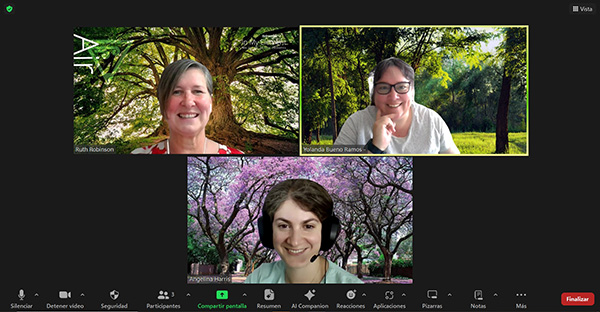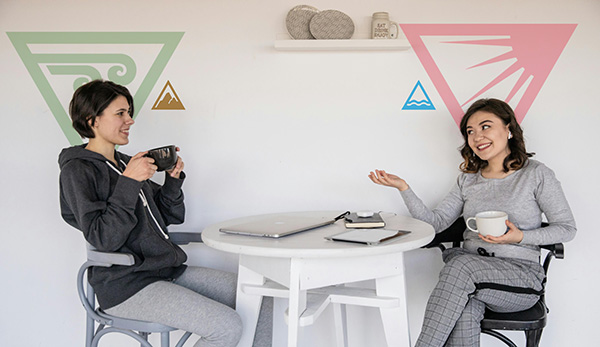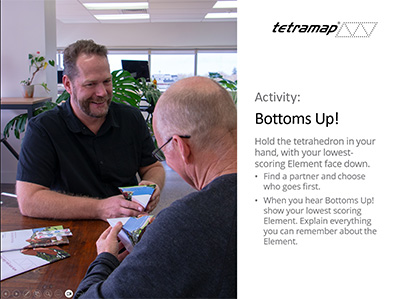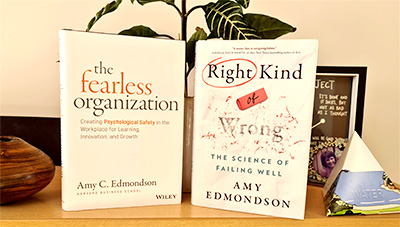Newsletter June 2024
Diversity – crossing cultures
 Following TetraMap’s successful launch in Vietnam in March, the expansion continues with its rollout into Turkey in the next couple of months. This includes new translated resources in Turkish to add to the Vietnamese versions.
Following TetraMap’s successful launch in Vietnam in March, the expansion continues with its rollout into Turkey in the next couple of months. This includes new translated resources in Turkish to add to the Vietnamese versions.
Earlier this year 41 North business school in Turkey certified three of their team on the digital certification course with Master Facilitator, Emma Mauger. 41 North specialise in cutting edge learning techniques and is dedicated to improving business practices in the digital transformation age. They are keen to roll out TetraMap in Turkey, complete with brand new translated resources, and are already looking to the future to take it to the United Arab Emirates (UAE).
Emma Mauger, Master Facilitator UK and Europe, explained: “TetraMap’s unique approach to drawing lessons from nature to understand and value diversity is one area of learning that our participants always enjoy exploring and that was certainly true for this team. I’m excited to see how TetraMap benefits their clients.”
TetraMap is centred around one core belief – strength lies in valuing differences. This makes it a natural choice for organizations when it comes to diversity and inclusion.
Ruth Robinson, General Manager TetraMap UK and Europe, added: “In a recent digital meeting between myself from the UK , Yolanda in Spain and Angelina in Bulgaria, TetraMap’s unique way of immediately engaging people was very apparent. It struck me how the common language of TetraMap allowed us to come together so easily from our different countries and appreciate our shared experiences as well as our differences. True diversity in action and real synergy – particularly when we saw we had all chosen a tree image for our background!”
When talking about cultural diversity in the workplace, it is the inclusion of people from different backgrounds, races, sexual orientations, political views and many other forms of diversity that make up successful teams. By simplifying the complexity of how people work together, TetraMap enables teams to foster and leverage their natural diversity to creatively solve organisational challenges together. Diversity fuels synergy, differences provoke creativity.
For more on Diversity and Creativity check out Louise’s five minute video.
Embracing the lowest Element – ‘show your bottom’

You will hear it over and over again from our Master Facilitators – ‘Trust the process’ – and we continue our deeper dive into our processes, this time exploring your lower Element thanks to an email from Amir Rizvi, TetraMap facilitator and Group Director of Academy from CitNOW.
We caught Amir’s interest in our last newsletter when Master Facilitator Ian Blackwell highlighted the lowest preference exercise, or as some know it ‘show your bottom’ on the tetrahedron.
Amir was keen to focus on this more in CitNOW Group’s TetraMap workshops: “I believe understanding your lower elements is just as important as understanding your natural preference to fully benefit from the fruits of TetraMap.”
4 easy ways to harness your lower Elements
 In the TetraMap resources the Why Are You Like That (WAYLT) powerpoint presentation has two slides which refer to an activity called ‘Bottoms Up’ (slide 54 and 55). This is a key reminder that we not only need to focus on our highest preferences but our lowest Element too. The languaging tips get people talking about what they can remember from the Elemental presentations and then talking about a time where they’ve used their lowest element successfully. It is an important step or bridge, so they can begin to notice and recognise different words, tone, gestures, connections. This is where the ‘turn irritations into insights’ message becomes very clear.
In the TetraMap resources the Why Are You Like That (WAYLT) powerpoint presentation has two slides which refer to an activity called ‘Bottoms Up’ (slide 54 and 55). This is a key reminder that we not only need to focus on our highest preferences but our lowest Element too. The languaging tips get people talking about what they can remember from the Elemental presentations and then talking about a time where they’ve used their lowest element successfully. It is an important step or bridge, so they can begin to notice and recognise different words, tone, gestures, connections. This is where the ‘turn irritations into insights’ message becomes very clear.- It’s good to allow time to reflect critically on this and you can also link it to the ‘under stress’ activity in the WAYLT workbook. Getting participants to ‘see’ this by underlining the words in the snippets of conversation in each activity is good, and if you have time you can get the participants to write some snippets of their own that are particularly relevant to an everyday situation in your context.
- Begin building empathy by considering something such as planning an event for a team building day. What might your lowest Element overlook, or assume others don’t need?
- Set an exercise where they will need to practice communicating with someone who has their highest Element to your lowest Element in pairs. Do whatever is real and relevant in your context. If you have the time, you could arrange a meeting encouraging another person to speak up or listen more. Or encourage their input in communicating a critical instruction, some important news, or an in the moment coaching conversation.
Master Facilitator Ian Blackwell explores this further in his recent blog.
Valuing Difference – Psychological safety and TetraMap
Top of the TetraMap reading list this month is a new book, ‘Right Kind of Wrong: The Science of Failing Well’, by Amy Edmondson. In it, Amy draws on a lifetime’s research into the science of ‘psychological safety’ to show that the most successful cultures are those in which you can fail openly, without your mistakes being held against you.
 Psychological safety is the belief that you will not be punished or humiliated for speaking up with ideas, questions, concerns, or mistakes, and the team is safe for interpersonal risk taking.
Psychological safety is the belief that you will not be punished or humiliated for speaking up with ideas, questions, concerns, or mistakes, and the team is safe for interpersonal risk taking.
It’s a recommended read from TetraMap International Director, Louise Duncan: “I love how it aligns with TetraMap in allowing people to feel that their diversity is celebrated and valued, and that it’s safe to be who they are and to speak up – particularly giving them courage to do so when they need to and knowing they will be heard. Speaking up can simply help to improve things, and on a bigger scale may help to prevent some catastrophic and complex failures.
“I highly recommend this book, especially to those of you that work with large organisations or have tough leadership coaching challenges. We have everything in our TetraMap toolbox to help organisations who need to push the boundaries while ensuring psychological safety.
“So much so, that this and Amy’s previous book, The Fearless Organization, are recommended reading and included in our Master Facilitator programme participant resources. Amy’s latest book gives a deeper understanding into how failure can be turned into opportunity – such as the 3M post it notes – and much as we do with TetraMap by focusing on encouraging openness, taking responsibility, and being curious, lifelong learners. I love how she describes us fallible human beings, a very important reminder for us all.”
‘When a group is higher in psychological safety, it’s likely to be more innovative, do higher-quality work, and enjoy better performance, compared to a group that is low in psychological safety. One of the most important reasons for these different outcomes is that people in psychologically safe teams can admit their mistakes. These are teams where candor is expected. It’s not always fun, and certainly it’s not always comfortable, to work in such a team because of the difficult conversations you will sometimes experience. Psychological safety in a team is virtually synonymous with a learning environment in a team. Everyone makes mistakes (we are all fallible), but not everyone is in a group where people feel comfortable speaking up about them. And it’s hard for teams to learn and perform well without psychological safety.’ (Edmondson, 2023, p. 16).
Visit our website to listen to Louise’s interview with Amy Edmondson where she reveals more about her past work with Buckminster Fuller and talks about her previous book, The Fearless Organization: Creating Psychological Safety in the Workplace for Learning, Innovation, and Growth.
Anyone looking to read more about the relationship between Tetramap and psychological safety can find two excellent stories on our website, a case study from Anna Bolton, Master TetraMap Facilitator, NZ and a blog by Emma Mauger, Master TetraMap Facilitator, UK.
Improving Facilitation – Catalytic questions

A recent face-to-face TetraMap certification course highlighted just how tricky it can be to form catalytic questions to get a response that reflects each element’s preferences, perspectives and beliefs. There are many right answers, and the right question can accelerate learning, create a powerful shift in thinking and help you make the most of your TetraMap workshop and outcomes.
We asked four of our expert Master TetraMap Facilitators for their top tips to formulating the most effective questions.
Kataraina Pipi – New Zealand Aotearoa
Catalytic questions are useful for gaining clarity around a workshop intent and approach. We ask them to ensure that we get a response from all four elemental perspectives, however framing the question takes a number of iterations, and that’s a good sign.
My advice is to keep going until you get the question that resonates with all four elements. They work because they are a ‘hook’ into the kaupapa or topic, particularly when it speaks to ‘me’ – make it personal. It’s important because the question helps to solidify and transform thinking and can bring in an element of curiosity, interest and excitement.
Catalytic questions need some practice to formulate them well, but not overly so. Instead of jumping to solutions, the formulation of catalytic questions forces our clients and ourselves, to really reflect the topic at hand first – it invites us to stay in the problem zone just a little bit longer.
Sometimes, we need to ask for their patience to stay there – however, it pays off. We can deep dive into topics that are current and fully relevant to our clients. This adds so much, especially to their first touchpoint with TetraMap, for example a WAYLT workshop. For some, this is where they understand the full potential of TetraMap!
Catalytic questions are an excellent tool for drawing out and highlighting different elemental perspectives and priorities. It leads to all sorts of ‘aha!’ moments when a group from one element suddenly realises that there is a whole load of important stuff to consider that they wouldn’t ever have thought of – but that another element has highlighted!
My view is that the simpler and more direct they are, the better. In my experience, most facilitators try to explain or explore too much in the phrasing of a catalytic question, when actually a much simpler and more direct question will generate a better outcome. For example ‘How can we make sure everyone contributes to the success of this project’ might lead to confused responses as people don’t know whether they answering for their own element, or trying to think about what other elements might contribute, whereas ‘What factors will make this project a success?’ works brilliantly and really highlights the different elemental responses.
I’ve also noticed that often people try to do much with one catalytic question when actually they need to break it down into two or even three questions. For example, instead of ‘How can we work better as a team so that everyone contributes to our success?’ it should be broken down into ‘What would help us work better as a team?’, ‘What contribution do you make to this team?’ and ‘What does success look like?’
Raymond Yap Pik Hwee – Singapore
A catalytic question is a thought-provoking and insightful question that sparks meaningful discussions, challenges assumptions, and encourages creative thinking. Here are some characteristics of a good catalytic question:
- Open-ended: Encourages exploration and discussion
- Thought-provoking: Challenges assumptions and sparks curiosity
- Relevant: Connected to the context or topic at hand
- Clear: Easy to understand and interpret.
Examples of catalytic questions:
- What are the implications of…?
- How might we…?
- What would happen if…?
- What are the key drivers of…?
- How does this relate to our goals/values?
- What are the potential risks/opportunities?
- How can we leverage/stretch…?
In summary, the goal of a catalytic question is to stimulate creative thinking, exploration, and meaningful discussions!
Take a look on our website at Louise’s video offering a simple guide to how to use catalytic questions.
About the Co-founders of TetraMap, Yoshimi & Jon Brett

Here we are then…almost 25 years from the birth of TetraMap. Actually, she was born in 1997 and was considered ‘… a fun tool that might help people better understand self and each other.’ As we entered the world of corporate facilitation, our model came to address ‘communication violence in the workplace’…in a gentle, fun way.
TetraMap was launched in 2000 followed by the publication of our book, TetraMap: Develop People and Business the Way Nature Intended. Surprised but willing…we delivered our first TetraMap Facilitator Certification Course in 2003. The rest is history. We’re absolutely thrilled that so many wonderful facilitators have found TetraMap not only of value as a useful facilitation tool…but more importantly, of value to them personally.
Retired and post-COVID 5 years ago…we’ve relished the time to focus on Buckminster Fuller’s prophetic work, climate action and justice…and AI (Ancestral Intelligence). We’ve developed a model called Emérgéntly that builds on TetraMap. Emérgéntly is a trimtab for TetraMappers to explore how we can accelerate change toward a regenerative future.